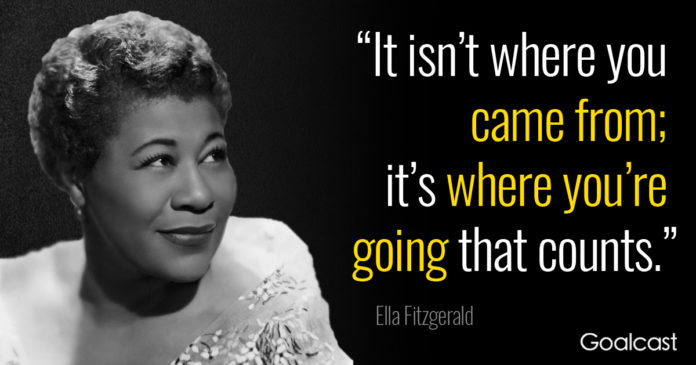The Queen of Jazz
By: Whitney Holmes
“Music is the universal language… it brings people closer together.”– Ella Fitzgerald
Background Information on Jazz Music
Ella Fitzgerald is one of, if not the most, popular Jazz singer in America. Jazz is often times considered to be the most revolutionary genre of African American music. Many Americans refer to Jazz as America’s classical music or African American classical music. Jazz was prominent and contributed to the social implications of many historical eras in America such as: urbanization, racism, innovation of broadcasting and radio, modernism, the World Wars, and the Civil Rights Movement. Key components of Jazz consist of improvisation, syncopation, swing, blues, and harmonic complexity. Although jazz was popular throughout the entire United States, New Orleans and Chicago were the heart of Jazz music. New Orleans is known to be the birthplace of Jazz. The extremely diverse demographics of New Orleans people contributed to the development of New Orleans Jazz such as: whites, blacks, creoles, and Caribbean. White, black, creole, and Caribbean people lived in New Orleans. The convergence of Creole musicians and black musicians influenced the sound of jazz. Notable instruments used in New Orleans jazz included the clarinet, cornet, trombone, guitar, bass, and drums. Following World War I, a significant amount of African Americans migrated to or around the city of Chicago. Many New Orleans jazz musicians were also part of this migration such as legendary Louis Armstrong. Many African American owned clubs on the southside of Chicago became a thriving nightlife for jazz musicians. This nightlife and destination for talented jazz musicians led to interracial interactions due to whites enjoying the music. Over the years, jazz has both sustained its traditional sound and continued to revolutionize for almost a century.
Ella Fitzgerald Before Her Fame
Becoming "The First Lady of Song"
Ella Fitzgerald or “The First Lady of Song”, was born on April 25, 1917 in Newport News, VA. Shortly after her birth, Ella and her mother moved to New York to live with her mother’s boyfriend, and later her half-sister. Ella did not have an ideal childhood. She encountered many obstacles that contributed to her troubled adolescent self. Her mother died in 1932, and shortly after her step father passed away. Following her mother’s death, Ella’s aunt moved her and her younger sister back to Virginia. Ella struggled with her unfortunate family situation which led her happiness to deteriorate during this time of her life. Due to multiple discipline offenses and getting into trouble with the police, Ella was sent to a reform school. The conditions at this reform school were far from humane in which Ella eventually escaped when she was 15 years old. At this point in her life, Ella was homeless, young, and had nowhere to go. Most people would consider a person in this situation to become another unfortunate statistic, but Ella would go on to be the legendary jazz singer she is known to be today.
When Ella was young and while Ella’s mother and stepfather were alive, the family would attend different shows at the Apollo in New York. Coincidentally, the Apollo unintentionally became the start of Ella’s singing career. Ella’s name was randomly pulled to perform at the Apollo one night where she at first, intended on dancing. However, the performers before her were known to be the best dancers around. Being the self-conscious and shy person Ella was known to be, she did not think her performance could surpass the performers before her. Instead, Ella decided to sing one of her mother’s favorite songs. The crowd loved her vocal performance so much, that they demanded an encore. In 1935, she was given the opportunity to perform with Tiny Bradshaw at the Harlem Opera House which led her meeting her mentor Chick Webb. Webb hired her to travel with the band after she performed for a crowd and was a success. The fire of Ella’s fame was lighted when she recorded a version of a nursery rhyme which led to over a million copies and hit number one on the charts. When Ella’s mentor passed away in 1939, Ella was named bandleader of the band: “Ella Fitzgerald and Her Famous Band”. After signing to manager Norman Granz, Ella joined the “Jazz at the Philharmonic” tour alongside Louis Armstrong. This tour led to the production of many albums and her songbook series which covered pieces by the Gershwins, Johnny Mercer, Irving Berlin, Duke Ellington, and several other jazz musicians. Prior to Ella Fitzgerald, the majority of Jazz consisted of instruments and little to no vocals. Ella was notorious for scatting, or the improvisation of melodies using her voice instead of instruments.
Awards and Achievements
Ella received several awards for her musical talents and her philanthropy. She was inducted into the Down Beat magazine Hall of Fame, received the Kennedy Center Honors, National Medal of Arts, honorary doctorates from Yale, Howard, and Dartmouth, Commander of Arts and Letters award, 13 Grammy awards, Recording Academy Lifetime Achievement Award, NAACP Award for lifetime achievement, and several others.

Sources
“Biography.” Ella Fitzgerald, 7 Apr. 2017, www.ellafitzgerald.com/about/biography.
Survey of African American Music Textbook

